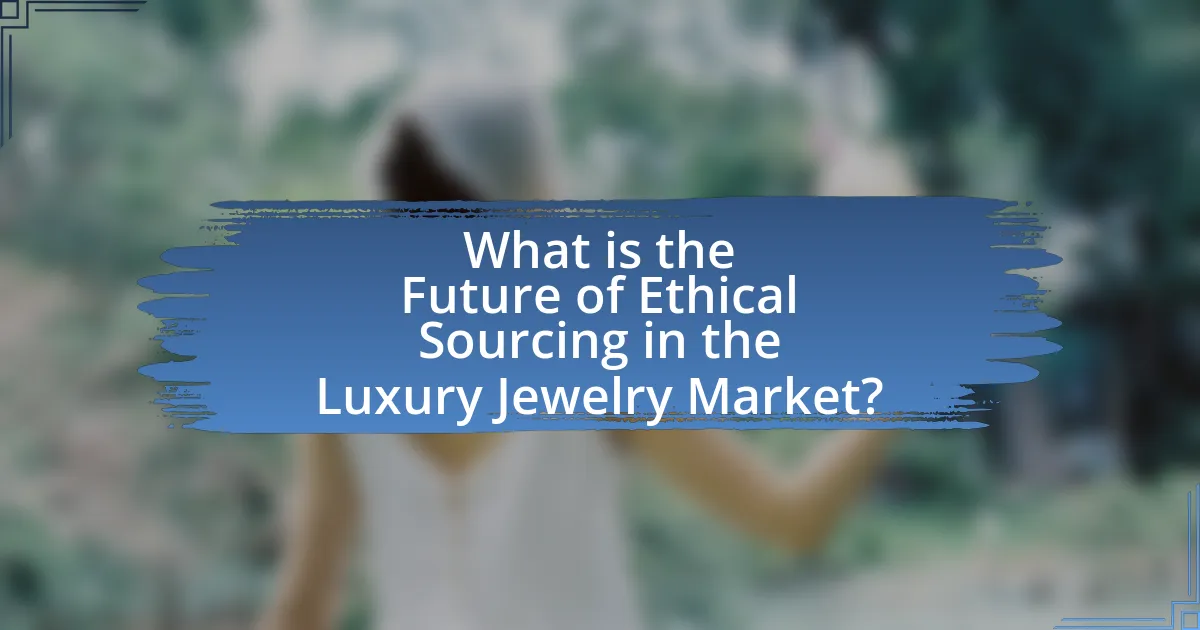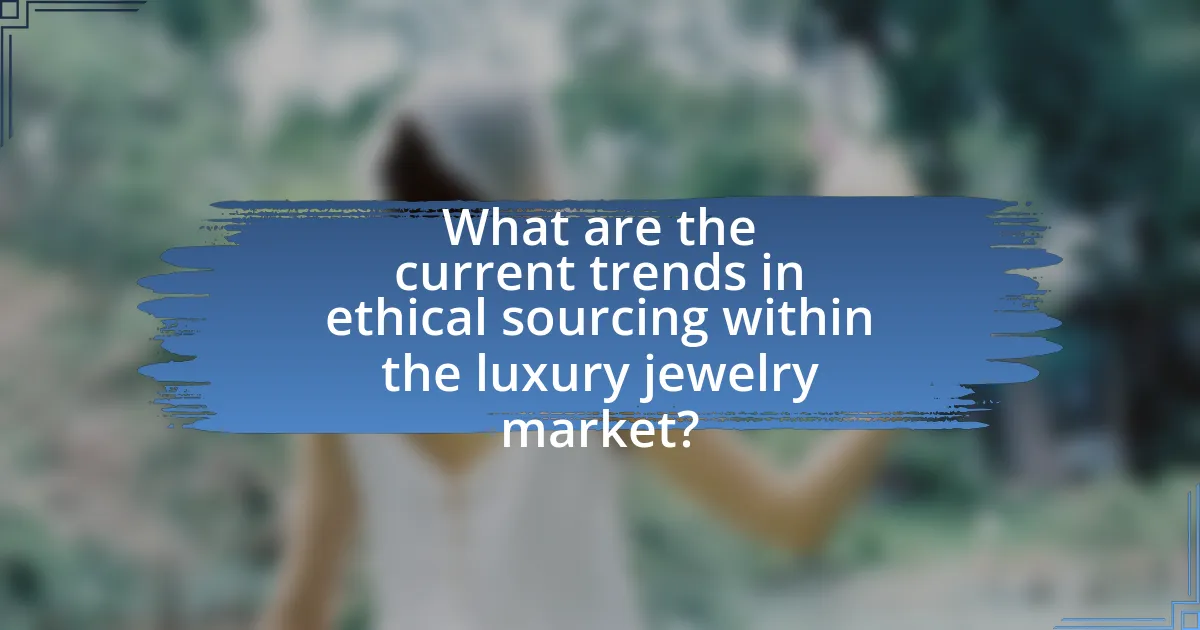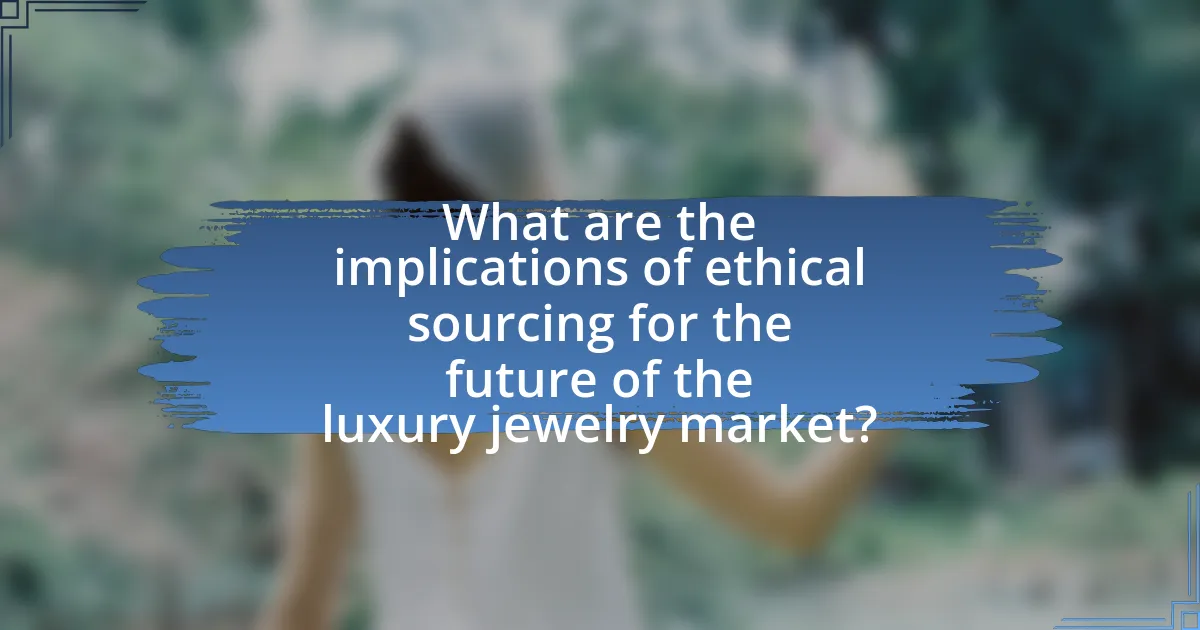The main entity of the article is the luxury jewelry market, specifically focusing on the future of ethical sourcing within this sector. The article outlines the increasing consumer demand for transparency and sustainability, highlighting the importance of ethical sourcing practices that respect human rights and environmental standards. Key principles such as traceability, fair labor practices, and the use of sustainable materials are discussed, along with the challenges luxury brands face in implementing these practices. Additionally, the role of technology, particularly blockchain, in enhancing supply chain transparency and the impact of certifications on consumer trust are examined. The article concludes by emphasizing the implications of ethical sourcing for brand reputation and market competition in the luxury jewelry industry.

What is the Future of Ethical Sourcing in the Luxury Jewelry Market?
The future of ethical sourcing in the luxury jewelry market is increasingly focused on transparency and sustainability. As consumer demand for ethically sourced materials rises, luxury brands are adopting traceability measures to ensure that gemstones and metals are sourced responsibly. For instance, the Responsible Jewelry Council has established standards that many luxury brands are beginning to follow, promoting ethical practices throughout the supply chain. Additionally, a 2021 survey by McKinsey & Company indicated that 67% of consumers consider sustainability when making luxury purchases, highlighting the market’s shift towards ethical sourcing. This trend is expected to continue, as brands that prioritize ethical sourcing are likely to gain a competitive advantage and foster consumer loyalty.
How is ethical sourcing defined within the luxury jewelry sector?
Ethical sourcing in the luxury jewelry sector is defined as the procurement of materials in a manner that respects human rights, environmental sustainability, and fair labor practices. This definition encompasses the traceability of gemstones and precious metals, ensuring they are sourced from conflict-free zones and produced under conditions that do not exploit workers. For instance, initiatives like the Kimberley Process Certification Scheme aim to prevent the trade of conflict diamonds, thereby reinforcing the commitment to ethical sourcing within the industry.
What are the key principles of ethical sourcing in jewelry?
The key principles of ethical sourcing in jewelry include transparency, sustainability, and fair labor practices. Transparency ensures that consumers are informed about the origins of materials, allowing them to make informed choices. Sustainability focuses on minimizing environmental impact through responsible mining and sourcing practices, such as using recycled metals and conflict-free gemstones. Fair labor practices guarantee that workers involved in the jewelry supply chain receive fair wages and work in safe conditions, as highlighted by initiatives like the Kimberley Process, which aims to prevent the trade of conflict diamonds. These principles collectively promote a more responsible and ethical jewelry industry.
How does ethical sourcing differ from traditional sourcing methods?
Ethical sourcing prioritizes social and environmental responsibility, contrasting with traditional sourcing methods that often focus solely on cost and efficiency. In ethical sourcing, companies ensure that materials are obtained in a manner that respects human rights, promotes fair labor practices, and minimizes environmental impact. For instance, according to a 2021 report by the Ethical Trading Initiative, ethical sourcing practices can lead to improved worker conditions and sustainable resource management, which are often overlooked in traditional methods that may exploit labor and degrade ecosystems.
Why is ethical sourcing becoming increasingly important in the luxury jewelry market?
Ethical sourcing is becoming increasingly important in the luxury jewelry market due to rising consumer demand for transparency and sustainability. Consumers are now more informed and concerned about the origins of materials, particularly precious metals and gemstones, which often involve environmental degradation and human rights violations. According to a 2021 survey by the Ethical Consumer, 70% of consumers are willing to pay more for ethically sourced products, highlighting a significant shift in purchasing behavior. This trend compels luxury brands to adopt ethical sourcing practices to maintain their reputation and meet consumer expectations, ultimately driving the industry towards more responsible practices.
What consumer trends are driving the demand for ethically sourced jewelry?
The demand for ethically sourced jewelry is primarily driven by consumer trends emphasizing sustainability, transparency, and social responsibility. Increasing awareness of environmental issues and the ethical implications of mining practices has led consumers to seek jewelry that aligns with their values. According to a 2021 survey by the Ethical Consumer, 66% of respondents stated they would pay more for products that are ethically sourced. Additionally, the rise of social media has amplified the visibility of brands that prioritize ethical practices, influencing consumer purchasing decisions. This trend is further supported by the growing millennial and Gen Z demographics, who prioritize ethical consumption, with 73% of millennials willing to spend more on sustainable goods, as reported by Nielsen in 2015.
How do ethical concerns impact brand reputation in the luxury jewelry industry?
Ethical concerns significantly impact brand reputation in the luxury jewelry industry by influencing consumer trust and purchasing decisions. Brands that fail to address issues such as conflict diamonds, environmental sustainability, and labor practices risk damaging their image and losing market share. For instance, a 2020 survey by the Ethical Consumer found that 66% of consumers are willing to pay more for ethically sourced products, highlighting the importance of ethical practices in maintaining a positive brand reputation. Additionally, high-profile cases of unethical sourcing have led to public backlash and decreased sales for brands involved, demonstrating that ethical concerns are not just moral issues but also critical business factors.
What challenges does the luxury jewelry market face in implementing ethical sourcing?
The luxury jewelry market faces significant challenges in implementing ethical sourcing, primarily due to the complexity of supply chains and the lack of transparency. Many gemstones and precious metals are sourced from regions with poor labor practices and environmental regulations, making it difficult for brands to ensure that their materials are ethically obtained. For instance, the Kimberley Process, aimed at preventing the trade of conflict diamonds, has been criticized for its ineffectiveness, as it does not cover all types of human rights abuses associated with diamond mining. Additionally, the high demand for luxury goods often leads to compromises on ethical standards, as consumers prioritize aesthetics and brand prestige over sourcing practices. These factors create a challenging environment for luxury jewelry brands striving to adopt ethical sourcing practices.
What are the common obstacles luxury brands encounter in sourcing ethically?
Luxury brands commonly encounter several obstacles in sourcing ethically, including lack of transparency in supply chains, high costs associated with ethical materials, and difficulty in verifying the ethical practices of suppliers. The complexity of global supply chains often obscures the origins of materials, making it challenging for brands to ensure that their sourcing aligns with ethical standards. Additionally, ethical materials, such as conflict-free diamonds or sustainably sourced gold, typically come at a premium price, which can deter brands focused on profit margins. Furthermore, the verification process for suppliers’ ethical claims can be cumbersome and resource-intensive, leading to skepticism about the authenticity of certifications. These factors collectively hinder luxury brands from fully committing to ethical sourcing practices.
How can luxury jewelry brands overcome these challenges?
Luxury jewelry brands can overcome challenges in ethical sourcing by implementing transparent supply chain practices and collaborating with certified ethical suppliers. By adopting blockchain technology, brands can trace the origin of materials, ensuring they are sourced responsibly. For instance, companies like De Beers have successfully utilized blockchain to verify the provenance of diamonds, enhancing consumer trust. Additionally, engaging in partnerships with organizations focused on ethical mining can help brands align with sustainable practices, as seen with the Responsible Jewelry Council, which sets standards for ethical sourcing in the industry.
How is technology influencing ethical sourcing in the luxury jewelry market?
Technology is significantly influencing ethical sourcing in the luxury jewelry market by enhancing traceability and transparency throughout the supply chain. Advanced technologies such as blockchain enable brands to track the origin of materials, ensuring that gemstones and metals are sourced responsibly and ethically. For instance, De Beers utilizes blockchain to provide a digital ledger that verifies the provenance of diamonds, thereby assuring consumers that their purchases are conflict-free. Additionally, artificial intelligence and machine learning are being employed to analyze supplier practices and detect unethical sourcing, further promoting accountability. These technological advancements not only foster consumer trust but also encourage sustainable practices within the industry.
What role do blockchain and traceability play in ethical sourcing?
Blockchain and traceability are crucial in ethical sourcing as they provide transparent and immutable records of a product’s journey from origin to consumer. This technology enables stakeholders to verify the authenticity and ethical standards of materials, ensuring that they are sourced responsibly. For instance, a study by the World Economic Forum highlights that blockchain can reduce supply chain fraud by up to 50%, thereby enhancing trust among consumers and businesses. By utilizing blockchain, luxury jewelry brands can demonstrate compliance with ethical sourcing practices, such as conflict-free sourcing of gemstones, which is increasingly demanded by consumers.
How can technology enhance transparency in the supply chain?
Technology enhances transparency in the supply chain by enabling real-time tracking and data sharing among all stakeholders. For instance, blockchain technology allows for immutable records of transactions, ensuring that every step of the supply chain is documented and verifiable. According to a 2020 study by the World Economic Forum, implementing blockchain in supply chains can reduce information asymmetry and increase trust among participants. Additionally, Internet of Things (IoT) devices provide continuous monitoring of goods, allowing companies to track the origin and journey of materials, which is crucial for ethical sourcing in the luxury jewelry market. This combination of technologies fosters accountability and helps consumers make informed choices about the products they purchase.

What are the current trends in ethical sourcing within the luxury jewelry market?
Current trends in ethical sourcing within the luxury jewelry market include increased transparency, the use of lab-grown diamonds, and a focus on sustainable materials. Transparency is being prioritized as brands disclose their supply chains and sourcing practices to ensure ethical compliance. The rise of lab-grown diamonds, which offer a conflict-free alternative to mined stones, is gaining popularity among consumers who value sustainability. Additionally, luxury brands are increasingly sourcing recycled metals and responsibly mined gemstones, aligning with consumer demand for environmentally friendly practices. These trends reflect a broader shift towards responsible consumption in the luxury sector, driven by consumer awareness and advocacy for ethical practices.
How are luxury brands adapting to consumer demands for ethical sourcing?
Luxury brands are adapting to consumer demands for ethical sourcing by implementing transparent supply chains and adopting sustainable practices. Many luxury jewelry brands are now prioritizing the use of conflict-free materials and certified ethical gemstones, ensuring that their sourcing aligns with social and environmental standards. For instance, brands like Tiffany & Co. have committed to sourcing diamonds from responsible mines and have established traceability protocols to verify the origins of their materials. Additionally, according to a 2021 report by McKinsey & Company, 67% of consumers in the luxury market are willing to pay more for sustainable products, indicating a significant shift in consumer preferences that luxury brands are responding to by enhancing their ethical sourcing strategies.
What initiatives are luxury jewelry brands taking to promote ethical practices?
Luxury jewelry brands are implementing various initiatives to promote ethical practices, including sourcing materials from conflict-free zones and adopting sustainable mining practices. For instance, brands like Tiffany & Co. have committed to sourcing diamonds from suppliers that adhere to the Kimberley Process, which aims to prevent the trade of conflict diamonds. Additionally, companies such as Chopard have launched the “Journey to Sustainable Luxury” initiative, focusing on using responsibly sourced gold and ensuring fair labor practices in their supply chains. These efforts are supported by certifications from organizations like the Responsible Jewelry Council, which sets standards for ethical sourcing and production in the jewelry industry.
How are collaborations between brands and NGOs shaping ethical sourcing?
Collaborations between brands and NGOs are significantly shaping ethical sourcing by establishing standards and practices that promote sustainability and social responsibility. These partnerships often lead to the development of certification programs, such as Fair Trade or Responsible Jewelry Council standards, which ensure that materials are sourced ethically and that workers are treated fairly. For instance, the collaboration between luxury brands and NGOs has resulted in initiatives that trace the origin of gemstones, ensuring they are conflict-free and sourced from environmentally responsible mines. This approach not only enhances brand reputation but also meets the growing consumer demand for transparency and ethical practices in the luxury jewelry market.
What impact do certifications and standards have on ethical sourcing?
Certifications and standards significantly enhance ethical sourcing by establishing clear guidelines and benchmarks for responsible practices. These frameworks, such as the Responsible Jewellery Council’s Code of Practices, ensure that sourcing processes are transparent, traceable, and adhere to ethical labor and environmental standards. For instance, adherence to these certifications can lead to improved supply chain accountability, as companies are required to demonstrate compliance through audits and reporting. This not only fosters consumer trust but also encourages businesses to adopt sustainable practices, ultimately contributing to the integrity of the luxury jewelry market.
What are the most recognized certifications for ethical sourcing in jewelry?
The most recognized certifications for ethical sourcing in jewelry include the Responsible Jewelry Council (RJC) certification, Fair Trade Gold certification, and the Kimberley Process Certification Scheme (KPCS). The Responsible Jewelry Council certification ensures that companies adhere to ethical, social, and environmental standards throughout their supply chains. Fair Trade Gold certification guarantees that gold is sourced from small-scale miners who receive fair wages and work under safe conditions. The Kimberley Process Certification Scheme aims to prevent the trade of conflict diamonds by ensuring that diamonds are sourced from conflict-free zones. These certifications are widely acknowledged in the industry and serve as benchmarks for ethical practices in jewelry sourcing.
How do these certifications influence consumer trust and purchasing decisions?
Certifications significantly enhance consumer trust and influence purchasing decisions by providing verified assurance of ethical practices. For instance, certifications like Fair Trade and Responsible Jewelry Council (RJC) signify adherence to ethical sourcing standards, which consumers increasingly prioritize. According to a 2021 survey by Nielsen, 66% of global consumers are willing to pay more for sustainable brands, indicating that certifications can directly impact purchasing behavior. Furthermore, these certifications serve as a form of social proof, reassuring consumers that their purchases align with their values, thereby fostering loyalty and repeat business.
What role does sustainability play in the future of ethical sourcing?
Sustainability is crucial for the future of ethical sourcing as it ensures that materials are obtained in a manner that protects the environment and supports social equity. The luxury jewelry market increasingly prioritizes sustainable practices, such as sourcing conflict-free gemstones and using recycled metals, to meet consumer demand for responsible products. According to a 2021 report by McKinsey & Company, 67% of consumers consider sustainability when making luxury purchases, indicating a significant shift towards ethical sourcing practices. This trend not only enhances brand reputation but also drives innovation in sourcing methods, ensuring that the luxury jewelry industry aligns with global sustainability goals.
How are luxury jewelry brands integrating sustainability into their sourcing practices?
Luxury jewelry brands are integrating sustainability into their sourcing practices by adopting ethical sourcing standards and utilizing traceable materials. For instance, brands like Chopard and Tiffany & Co. have committed to sourcing gold from certified responsible mines, ensuring that their materials meet environmental and social criteria. Additionally, many luxury brands are increasingly using lab-grown diamonds, which significantly reduce the environmental impact associated with traditional diamond mining. According to a report by the Responsible Jewelry Council, over 70% of luxury jewelry brands are now prioritizing sustainability in their supply chains, reflecting a growing trend towards ethical sourcing in the industry.
What are the environmental impacts of ethical sourcing in the jewelry industry?
Ethical sourcing in the jewelry industry significantly reduces environmental impacts by promoting sustainable mining practices and minimizing ecological degradation. Sustainable mining methods, such as using less harmful chemicals and reducing land disturbance, help preserve biodiversity and protect ecosystems. For instance, companies that adhere to ethical sourcing standards often engage in responsible sourcing of materials like gold and diamonds, which can lead to a decrease in deforestation and soil erosion. Additionally, ethical sourcing initiatives frequently include commitments to rehabilitate mining sites, further mitigating long-term environmental damage. According to a report by the World Gold Council, responsible gold mining can reduce greenhouse gas emissions by up to 30% compared to traditional methods, highlighting the positive environmental effects of ethical sourcing practices in the jewelry sector.

What are the implications of ethical sourcing for the future of the luxury jewelry market?
Ethical sourcing will significantly reshape the luxury jewelry market by increasing consumer demand for transparency and sustainability. As consumers become more aware of the social and environmental impacts of their purchases, luxury brands that prioritize ethical sourcing will likely gain a competitive advantage. A 2021 survey by McKinsey & Company found that 67% of consumers consider sustainability when making luxury purchases, indicating a strong market shift towards ethically sourced materials. This trend compels luxury jewelry brands to adopt responsible sourcing practices, which can enhance brand loyalty and attract a new customer base focused on ethical consumption.
How will ethical sourcing shape consumer behavior in the luxury jewelry market?
Ethical sourcing will significantly influence consumer behavior in the luxury jewelry market by increasing demand for responsibly sourced materials. As consumers become more aware of the social and environmental impacts of their purchases, they are increasingly prioritizing brands that demonstrate transparency and ethical practices. A 2021 survey by McKinsey & Company found that 67% of consumers consider sustainability an important factor when purchasing luxury goods, indicating a shift towards ethical consumption. This trend compels luxury brands to adopt ethical sourcing practices to attract and retain customers, ultimately reshaping the market landscape.
What are the potential long-term benefits for brands that prioritize ethical sourcing?
Brands that prioritize ethical sourcing can experience enhanced consumer loyalty and brand reputation over the long term. By committing to ethical practices, these brands attract a growing segment of consumers who value sustainability and social responsibility, leading to increased sales and market share. Research indicates that 66% of global consumers are willing to pay more for sustainable brands, highlighting the financial incentive for ethical sourcing. Furthermore, ethical sourcing can mitigate risks associated with supply chain disruptions and regulatory compliance, ultimately leading to more stable operations and profitability.
How might ethical sourcing influence market competition among luxury brands?
Ethical sourcing significantly influences market competition among luxury brands by enhancing brand reputation and consumer loyalty. As consumers increasingly prioritize sustainability and ethical practices, luxury brands that adopt ethical sourcing can differentiate themselves in a crowded market. For instance, a 2021 study by McKinsey & Company found that 66% of consumers are willing to pay more for sustainable brands, indicating that ethical sourcing can lead to increased sales and market share. Consequently, luxury brands that fail to implement ethical sourcing may lose competitive advantage, as consumers gravitate towards brands that align with their values.
What best practices can luxury jewelry brands adopt for effective ethical sourcing?
Luxury jewelry brands can adopt several best practices for effective ethical sourcing, including establishing transparent supply chains, conducting regular audits, and collaborating with certified ethical suppliers. Transparent supply chains enable brands to trace the origin of materials, ensuring they are sourced responsibly. Regular audits of suppliers help verify compliance with ethical standards, reducing the risk of human rights violations and environmental harm. Collaborating with certified ethical suppliers, such as those recognized by the Responsible Jewelry Council, ensures that materials meet established ethical criteria, promoting sustainability and fair labor practices. These practices are essential for building consumer trust and aligning with growing market demands for ethical products.
What strategies can brands implement to ensure compliance with ethical standards?
Brands can implement several strategies to ensure compliance with ethical standards, including establishing a robust supply chain transparency framework. This involves conducting thorough audits of suppliers to verify their adherence to ethical practices, such as fair labor conditions and environmentally sustainable sourcing. For instance, the Responsible Jewelry Council provides certification standards that brands can adopt to demonstrate their commitment to ethical sourcing. Additionally, brands can engage in regular training programs for employees and suppliers to foster awareness of ethical standards and practices. Implementing a stakeholder engagement process allows brands to gather feedback from consumers and advocacy groups, ensuring that their practices align with societal expectations. These strategies collectively enhance a brand’s credibility and commitment to ethical standards in the luxury jewelry market.
How can brands effectively communicate their ethical sourcing efforts to consumers?
Brands can effectively communicate their ethical sourcing efforts to consumers by utilizing transparent storytelling and leveraging certifications. Transparent storytelling involves sharing detailed narratives about the sourcing process, including the origins of materials and the impact on communities, which builds trust and authenticity. For instance, brands can highlight partnerships with local artisans or initiatives that support fair labor practices. Additionally, leveraging certifications from recognized organizations, such as Fair Trade or the Responsible Jewelry Council, provides consumers with verifiable proof of ethical practices. According to a 2021 survey by Nielsen, 66% of global consumers are willing to pay more for sustainable brands, indicating that clear communication of ethical sourcing can enhance brand loyalty and consumer engagement.


